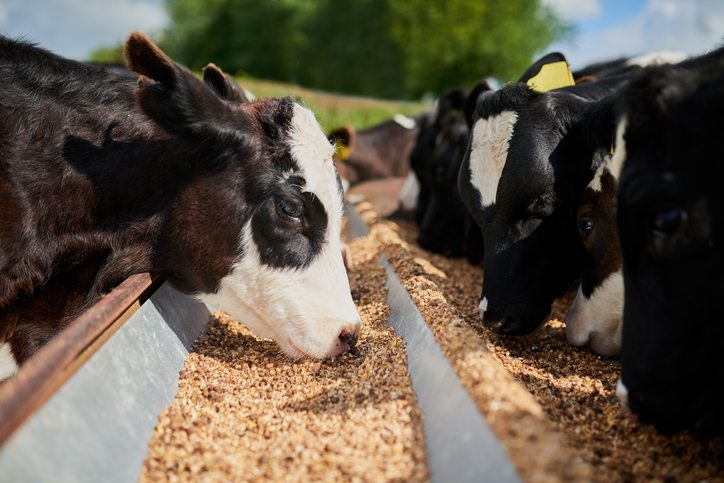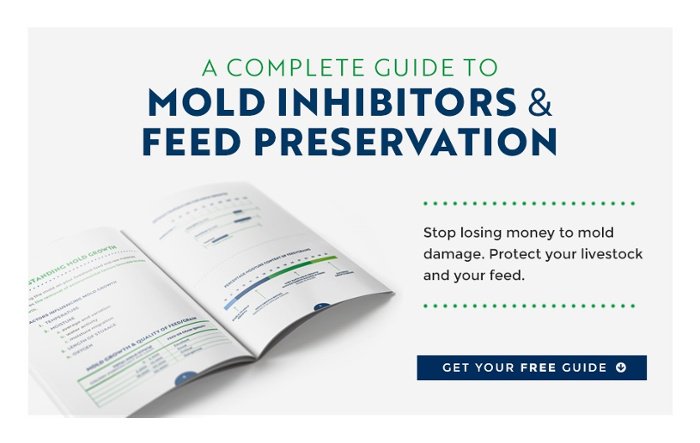
More than 300 types of mycotoxins are produced by molds, which means that there’s a good possibility your operation has encountered problems because of mold damage and mycotoxin production.
Finding ways to protect livestock health, maintain profitable levels of production, and eliminate expensive veterinary costs is critical to running a successful operation.
Mycotoxin Binders
Whether you want to lengthen the shelf life of feed or are focused on providing a nutritionally complete diet to your animals, mycotoxin binders work to enhance the quality of feed and raw materials while protecting livestock from dangerous health risks.
Find Out How You Can Eliminate Mold Problems with this FREE Guide
High-quality binders latch on to mycotoxins, preventing them from being absorbed by your livestock’s gut and entering the bloodstream.
Benefits of Using Mycotoxin Binders
- Reduces the chance of mycotoxicosis
- Improves animal health
- Boosts livestock productivity
- Avoids expensive veterinary costs
Toxin Binder Composition
The key to eliminating the production of mycotoxins that lead to dangerous health issues is selecting a mycotoxin binder with a proven composition. Many of the best mycotoxin binders include a variety of the following elements:
- Organic acids
- Activated charcoal
- Selected silicates
- Yeast cell wall components
- Surfactants and photogenic derivatives
Using mycotoxin binders is a great way to combat the loss of nutritive value in feeds that have been contaminated by toxins and have decreased in palatability. If you suspect that molds have contaminated your feed or raw materials, it’s essential that you immediately begin using binders. This will limit the possibility of disease due to absorption of toxins into the bloodstream.
Mycotoxin Products and The Species They Help
There are 6 things you need to consider when addressing mycotoxin problems:
- Mycotoxins lower the nutritional value and palatability of feeds and raw materials
- Mycotoxins hamper your livestock’s ability to use vitamins, proteins, fats, carbohydrates, and minerals
- Vital organ tissues can be damaged by mycotoxins, especially the rumen lining, liver, kidney, and intestinal tissue which lowers resistance to metabolic conditions like ketosis
- Mycotoxins can disrupt normal ovary function
- Mycotoxins suppress immune function, which lowers resistance to sickness and disease
- Mycotoxins can negatively impact the health and production of livestock
Mycotoxins can infect and harm a variety of livestock species, so it’s important to know what to look for.
Mycotoxin Binders in Poultry Feed
The effects of mycotoxins on the health and productivity of poultry depends on the type of mycotoxins produced as well as the level of contamination. Mycotoxin poisoning can cause weight loss, decreased feed efficiency, and lower egg production. Mycotoxin binders used in poultry feed provide an exceptional level of health security and a more efficient way for birds to utilize maximum levels of nutrients that can improve production rates.
Mycotoxin Binders for Dairy Cattle
Mycotoxin poisoning among dairy cows impacts the livestock by “reducing feed consumption, reducing nutrient utilization, altering rumen fermentation, suppressing immunity, altering reproduction, irritating tissues, and causing cellular death.”
There are 3 common symptoms of mycotoxin poisoning in dairy cattle:
- A decrease in milk production
- Infertility, abortion and decreased conception rates majorly due to zearalenone toxins
- Reduced intake of dry matter
The increase in mineral or salt consumption usually occurs when mycotoxins impact the ability of cattle to properly absorb nutrients. Using toxin binders for dairy cattle limits mycotoxin occurrence and reduces toxicity.
Mycotoxin Binder for Horses
Horses usually exhibit a variety of symptoms that indicate mycotoxin poisoning, including:
- Reduced feed intake
- Weight loss
- Respiratory issues
- Lower resistance to disease and sickness
- Poor growth rates
Supplement your horses’ diet with mycotoxin binders and bolster your efforts with healthy feed storage practices, such as maintaining low levels of humidity and proper ventilation. Following these steps can prevent serious equine health problems from occurring.
Using Mycotoxin Binders to Reduce Economic Loss and Improve Livestock Health
Routine use of mycotoxin binders will reduce toxin levels to a degree that will not impact livestock health or production rates. Common, expensive problems—like lameness, inflammation, and infertility—can all be a result of mycotoxin poisoning.
Here are 4 criteria for identifying successful mycotoxin binders:
- Successful trials prove efficacy
- Binds to a wide range of mycotoxins
- High absorption capacity
- Safe for animal consumption
Mycotoxins represent a massive economic loss for farmers and livestock operators each year. They force costs to skyrocket and require extensive labor to eliminate and control. Adding mycotoxin binders to feed not only improves livestock health and production levels, it also boosts profitability by eliminating costly veterinary services and other expenses associated with restoring livestock health.

